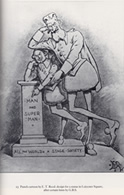
Bernard Shaw, Coincidentally
By Stanley Kauffmann
Coincidence is a suspect device in dramaturgy. Can there be a
teacher of playwriting anywhere who advises the use of coincidence
in structure? Yet it is a fact, odd and teasing, that Bernard
Shaw uses it frequently in plays that are now fixed in the world’s
treasury of drama.
Some examples. In Mrs. Warren’s Profession, the
clergyman father of Vivie‘s boyfriend turns out to be a
former lover of her mother. In You Never Can Tell, the
landlord of Dolly Clandon’s dentist turns out to be her
long-lost father. In Man and Superman, the longed-for
sweetheart of the brigand in the Sierra Nevada mountains turns
out to be the sister of the chauffeur he has just kidnapped. In
John Bull’s Other Island, the Irishman whom Broadbent
consults for guidance turns out to be from the same village as
Broadbent’s partner, Doyle. In Misalliance, the
pilot whose plane crashes in the garden of a country house turns
out to be the best friend of a young man staying in the house.
In Fanny’s First Play, the hooker who knows a certain
young man turns out to have been a cell mate of the young man’s
fiancee when the latter was in prison for civil disturbance. In
Heartbreak House, the burglar who breaks into that house
turns out to be a former member of Captain Shotover’s crew.
This list is incomplete.
“Turns out” is the operative phrase in these descriptions.
Shaw does the turning, knowingly, almost ostentatiously. But why
does this dramatist, whose technical skill grew breathtakingly
even as he swept through the first decade of his career, cling
to coincidence as he goes along and aloft?
Several explanations occur. First is a basic paradox in Shaw.
He considered himself a pioneer of the New Drama. (He said that,
after he had been heralding the New Drama in his theater criticism,
he found that there was none and had to supply it himself.) Yet
he loved the flavors of the nineteenth-century popular theater
that had absorbed him in Dublin and London, trumpery though the
plays usually were, and he particularly liked the way the audience
was engaged in a kind of proprietary relationship with the stage.
The theater of that day belonged to its audience in a
way that is now quite lost: people went to the theater (Dickens
describes it vividly) as if it were an extension of their homes.
The theater’s artifices, patent as they were, were almost
an etiquette. If Character A did this, then B must do that. The
public relished these arrangements. Shaw, despite his inspiration
by Ibsen and others, was reluctant to discard the heartiness of
this rapport. In fact, as Martin Meisel clarifies in Shaw
and the Nineteenth Century Theater, Shaw’s New Drama
frequently used armatures and character ideas from popular plays
of the past, providing them with the soundness they had lacked
yet exploiting their theatrical juiciness.
He clearly saw coincidence as part of his dramaturgic legacy.
But as a serious artist, he had to make sure that it did not fracture
verity. He understood that coincidence could successfully function
only in comedy. Even in Heartbreak House, which eventually
is a deeply grave play, the coincidence occurs in the second act,
which is comic.
But why did he want to use coincidences at all? Presumably he
could have constructed his plays without them; why, then, did
he risk (the apt word, I think) the use of coincidence? Here are
some possible reasons. First, they are enjoyable. If they are
handled with a kind of effrontery, rather than embarrassment,
and if the progress of the play up to that point has engaged the
audience, the coincidence conveys a thrill of neatness. It makes
us feel fulfillment of a wish. When Mr. Crampton turns out to
be Dolly’s father in You Never Can Tell, it seems
much less a trick than a desired comeliness. It seems part of
the nature of this play that its very shape should add to its
delight.
Beyond and perhaps beneath this factor is the peculiar truth that
coincidence, in the hands of a master, is a subtle compliment
to the audience. Shaw seems to be saying to us: “I know
that you know that this coincidence would be highly unlikely in
life; but I also know that, if I have done my job properly, you
will chuckle with me at that very fact, both because it is neat
and because we all want it to happen.” When a Shavian coincidence
is played before us -- or is read -- we hear him saying the above,
thus admitting us to a society of connoisseurs. Shaw leaves it
to the low-spirited and literal to balk at the unlikelihood of
the event. The rest of us are relishing the coincidence as a manifest
of theatrical life, set.pleasantly apart from the dailiness of
life off-stage.
Of course the toleration of coincidence, even a secret eagerness
for its appropriate use, has its dangers. I was once in a parodic
high-school show in which I played someone who was.needed in a
particular scene, and, to excuse my sudden appearance, the author
gave me the line, “I was in the neighborhood looking for
some real estate.” The line got the desired laugh, but the
audience was laughing with the author at the play, not, as in
Shaw, enjoying the play itself more. Like many other potentially
beneficial instruments in all the arts, coincidence used by clumsy
hands can merely obtrude. With Shaw, it helps to confirm the being
of the play as an event in art that illuminates the real world
yet is free of the real world’s limitations.
